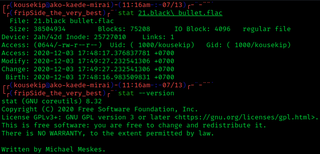Related Research Articles
ext2, or second extended file system, is a file system for the Linux kernel. It was initially designed by French software developer Rémy Card as a replacement for the extended file system (ext). Having been designed according to the same principles as the Berkeley Fast File System from BSD, it was the first commercial-grade filesystem for Linux.

The system utility fsck is a tool for checking the consistency of a file system in Unix and Unix-like operating systems, such as Linux, macOS, and FreeBSD. The equivalent programs on MS-DOS and Microsoft Windows are CHKDSK, SFC, and SCANDISK.

A virtual file system (VFS) or virtual filesystem switch is an abstract layer on top of a more concrete file system. The purpose of a VFS is to allow client applications to access different types of concrete file systems in a uniform way. A VFS can, for example, be used to access local and network storage devices transparently without the client application noticing the difference. It can be used to bridge the differences in Windows, classic Mac OS/macOS and Unix filesystems, so that applications can access files on local file systems of those types without having to know what type of file system they are accessing.
tmpfs is a temporary file storage paradigm implemented in many Unix-like operating systems. It is intended to appear as a mounted file system, but data is stored in volatile memory instead of a persistent storage device. A similar construction is a RAM disk, which appears as a virtual disk drive and hosts a disk file system.
A disk quota is a limit set by a system administrator that restricts certain aspects of file system usage on modern operating systems. The function of using disk quotas is to allocate limited disk space in a reasonable way.

stat is a Unix system call that returns file attributes about an inode. The semantics of stat vary between operating systems. As an example, Unix command ls uses this system call to retrieve information on files that includes:
Soft updates is an approach to maintaining file system meta-data integrity in the event of a crash or power outage. Soft updates work by tracking and enforcing dependencies among updates to file system meta-data. Soft updates are an alternative to the more commonly used approach of journaling file systems.

In computing, a file system or filesystem is a method and data structure that the operating system uses to control how data is stored and retrieved. Without a file system, data placed in a storage medium would be one large body of data with no way to tell where one piece of data stopped and the next began, or where any piece of data was located when it was time to retrieve it. By separating the data into pieces and giving each piece a name, the data are easily isolated and identified. Taking its name from the way a paper-based data management system is named, each group of data is called a "file". The structure and logic rules used to manage the groups of data and their names is called a "file system."
Filesystem in Userspace (FUSE) is a software interface for Unix and Unix-like computer operating systems that lets non-privileged users create their own file systems without editing kernel code. This is achieved by running file system code in user space while the FUSE module provides only a bridge to the actual kernel interfaces.
The Log-Structured File System is an implementation of a log-structured file system, originally developed for BSD. It was removed from FreeBSD and OpenBSD; the NetBSD implementation was nonfunctional until work leading up to the 4.0 release made it viable again as a production file system.
NILFS or NILFS2 is a log-structured file system implementation for the Linux kernel. It was developed by Nippon Telegraph and Telephone Corporation (NTT) CyberSpace Laboratories and a community from all over the world. NILFS was released under the terms of the GNU General Public License (GPL).
Extended file attributes are file system features that enable users to associate computer files with metadata not interpreted by the filesystem, whereas regular attributes have a purpose strictly defined by the filesystem. Unlike forks, which can usually be as large as the maximum file size, extended attributes are usually limited in size to a value significantly smaller than the maximum file size. Typical uses include storing the author of a document, the character encoding of a plain-text document, or a checksum, cryptographic hash or digital certificate, and discretionary access control information.
The following tables compare general and technical information for a number of file systems.

Marshall Kirk McKusick is a computer scientist, known for his extensive work on BSD UNIX, from the 1980s to FreeBSD in the present day. He was president of the USENIX Association from 1990 to 1992 and again from 2002 to 2004, and still serves on the board. He is on the editorial board of ACM Queue Magazine. He is known to friends and colleagues as "Kirk".
chattr is the command in Linux that allows a user to set certain attributes of a file. lsattr is the command that displays the attributes of a file.
The Orlov block allocator is an algorithm to define where a particular file will reside on a given file system (blockwise), so as to speed up disk operations.
Write Ahead Physical Block Logging (WAPBL) provides meta data journaling for file systems in conjunction with Fast File System (FFS) to accomplish rapid filesystem consistency after an unclean shutdown of the filesystem and better general use performance over regular FFS. With the journal, fsck is no longer required at system boot; instead, the system can replay the journal in order to correct any inconsistencies in the filesystem if the system has been shut down in an unclean fashion.

In Unix and operating systems inspired by it, the file system is considered a central component of the operating system. It was also one of the first parts of the system to be designed and implemented by Ken Thompson in the first experimental version of Unix, dated 1969.
A journaling file system is a file system that keeps track of changes not yet committed to the file system's main part by recording the goal of such changes in a data structure known as a "journal", which is usually a circular log. In the event of a system crash or power failure, such file systems can be brought back online more quickly with a lower likelihood of becoming corrupted.
References
Citations
- 1 2 3 "[base] Contents of /Head/Sys/Ufs/Ufs/Dinode.h".
- ↑ "Open Sources: Voices from the Open Source Revolution". 29 March 1999.
- ↑ McKusick, K M; Joy, W; Leffler, S; Fabry, R (August 1984). "A Fast File System for UNIX" (PDF). ACM Transactions on Computer Systems. 2 (3): 181–197. doi:10.1145/989.990. S2CID 222285164 . Retrieved 2013-04-08.
- ↑ Allen, Hervey (2005-06-20). "UFS2 and Soft Updates make for a powerful combination" (PDF). Introduction to FreeBSD, PacNOG I Workshop, Additional Topics. Network Startup Resource Center. p. 23. Retrieved 2013-04-08.
- ↑ "UFS Logging". Oracle Documentation. Retrieved 2022-09-27.
- ↑ "OpenBSD 2.9 Release". OpenBSD. 2001-06-01. Retrieved 2013-04-08.
- ↑ "OpenBSD 4.2 Release". OpenBSD. 2007-11-01. Retrieved 2013-04-08.
- ↑ "Make FFS2 the default filesystem". OpenBSD. 2020-04-05. Retrieved 2020-04-07.
- ↑ "Archived — Mac OS X 10.5 Leopard: Installing on a UFS-formatted volume". Apple, Inc. 2012-06-12. Retrieved 2013-04-08.
- ↑ "Lion won't mount any disk images with the built-in utility or Disk Utility". Apple Support Communities. Apple, Inc. 2011-08-05. Retrieved 2013-12-24.
Bibliography
- Marshall Kirk McKusick, William N. Joy, Samuel J. Leffler and Robert S. Fabry. A Fast File System for UNIX (PDF) (Technical report). Computer Systems Research Group, Computer Science Division, Department of Electrical Engineering and Computer Science, University of California, Berkeley . Retrieved 2013-04-08.
{{cite tech report}}: CS1 maint: multiple names: authors list (link) - Marshall Kirk McKusick, William N. Joy, Samuel J. Leffler and Robert S. Fabry (August 1984). "A Fast File System for UNIX" (PDF). ACM Transactions on Computer Systems. 2 (3): 181–197. doi:10.1145/989.990. S2CID 222285164 . Retrieved 2013-04-08.
{{cite journal}}: CS1 maint: multiple names: authors list (link) - Marshall Kirk McKusick; Keith Bostic; Michael J. Karels & John S. Quarterman (1996). "Local Filesystems; Local Filestores". The Design and Implementation of the 4.4BSD Operating System. Addison-Wesley. ISBN 0-201-54979-4.
- Marshall Kirk McKusick & Gregory R. Ganger (June 1999). "Soft Updates: A Technique for Eliminating Most Synchronous Writes in the Fast Filesystem" (PDF). Proceedings of the FREENIX Track: 1999 USENIX Annual Technical Conference. pp. 1–18. Retrieved 2013-04-08.
- Marshall Kirk McKusick (February 2002). "Running "fsck" in the Background". Proceedings of the BSDCon 2002. pp. 55–64. Retrieved 2013-04-08.
- Marshall Kirk McKusick (September 2003). "Enhancements to the Fast Filesystem To Support Multi-Terabyte Storage Systems". Proceedings of the BSDCon 2003. Retrieved 2019-02-07.
- Richard McDougall; Jim Mauro (2006). "15: The UFS File System". Solaris Internals: Solaris 10 and OpenSolaris Kernel Architecture (PDF) (2 ed.). Sun Microsystems Press/Prentice Hall. ISBN 0-13-148209-2.